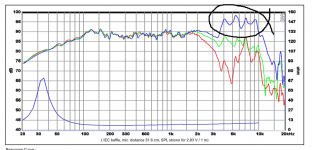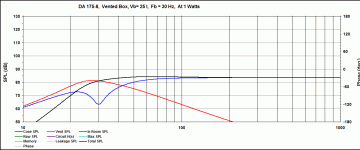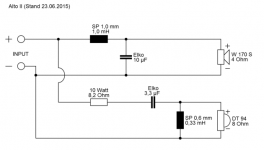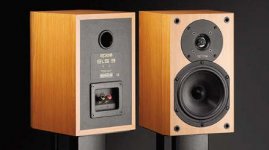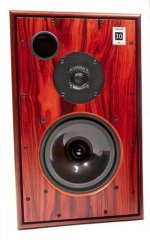Hi
Planning to build nice solid 2-way speaker. I am going to use these as daily drivers for music, creating nice background sound for cooking, wine drinking, just listening classic, soul, jazz music etc. They will be in my living room (small 15-20m2). High end quality will be the goal.
Tweeter driver will be: https://www.madisoundspeakerstore.c...covery-d2608/9130-1-textile-dome-hds-tweeter/
Now I cant decide what woofer should I use to match with this SS9130 tweeter. I am between these 2 options:
Dayton DSA175 new driver: Dayton Audio DSA175-8 6-1/2" Designer Series Aluminum Cone Woofer
Or known Seas driver ER18RNX: https://www.madisoundspeakerstore.c...stige-er18rnx-h1456-7-reed-paper-cone-woofer/
I would like to have enough bass also from these small speakers, this way that they satisfies me if I listen them daily. I read that Dayton needs very small enclosure, twice as small as Seas. Does because of that also low end lacks nice solid bass?! Daytons does not go so low as Seas, not to lose energy?
Another factor is cost/quality proportion etc. value. Daytons are twice cheaper also. But for this project I can spend more, because I am building speakers rarely and they are meant to satisfie me for a long period of time.
Any opinion and explanation is welcome, which one of these I should chose?
Planning to build nice solid 2-way speaker. I am going to use these as daily drivers for music, creating nice background sound for cooking, wine drinking, just listening classic, soul, jazz music etc. They will be in my living room (small 15-20m2). High end quality will be the goal.
Tweeter driver will be: https://www.madisoundspeakerstore.c...covery-d2608/9130-1-textile-dome-hds-tweeter/
Now I cant decide what woofer should I use to match with this SS9130 tweeter. I am between these 2 options:
Dayton DSA175 new driver: Dayton Audio DSA175-8 6-1/2" Designer Series Aluminum Cone Woofer
Or known Seas driver ER18RNX: https://www.madisoundspeakerstore.c...stige-er18rnx-h1456-7-reed-paper-cone-woofer/
I would like to have enough bass also from these small speakers, this way that they satisfies me if I listen them daily. I read that Dayton needs very small enclosure, twice as small as Seas. Does because of that also low end lacks nice solid bass?! Daytons does not go so low as Seas, not to lose energy?
Another factor is cost/quality proportion etc. value. Daytons are twice cheaper also. But for this project I can spend more, because I am building speakers rarely and they are meant to satisfie me for a long period of time.
Any opinion and explanation is welcome, which one of these I should chose?
My friend, the first mistake people make is choosing some unlikely drivers, then trying to decide what to do with them. 😀
Get your design first:
http://www.ampslab.com/starling.htm
DIY-Loudspeakers
Then it will work. 😎
I could add that the Dayton is a metal driver. These are in the advanced category because they need complex crossovers. Life is much easier with paper cones.
http://www.troelsgravesen.dk/SEAS_CA18RLY-COMPACT.htm
Get your design first:
http://www.ampslab.com/starling.htm
DIY-Loudspeakers
Then it will work. 😎
I could add that the Dayton is a metal driver. These are in the advanced category because they need complex crossovers. Life is much easier with paper cones.
http://www.troelsgravesen.dk/SEAS_CA18RLY-COMPACT.htm
Last edited:
This is a reasonably priced great sounding 6.5" woofer with decent bass, 8ohm to match the tweet AND good sensitivity
6" SB17NRXC35-8 :: SB Acoustics
6" SB17NRXC35-8 :: SB Acoustics
Sorry, Bill, I get cross at such rank bad advice to someone who is new to this. 🙄
I'd know what to do with that 5kHz cone-breakup, highlighted in black, but most people wouldn't.
6" SB17NRXC35-8 :: SB Acoustics
KISS (keep it simple...) is good advice.
Unless you have a detailed design.
I'd know what to do with that 5kHz cone-breakup, highlighted in black, but most people wouldn't.
6" SB17NRXC35-8 :: SB Acoustics
KISS (keep it simple...) is good advice.
Unless you have a detailed design.
Attachments
IMO.... (I may end up stranded mid-stream without an oar here...)
If you have limited space, the implication is limited space for speaker placement. Maybe consider smaller woofers in your main speakers and add a subwoofer.
If you have limited space, the implication is limited space for speaker placement. Maybe consider smaller woofers in your main speakers and add a subwoofer.
If you don't mind a kit, this one has the tweeter in it that you're interested in.
https://www.madisoundspeakerstore.com/2-way-speaker-kits/scan-speak-rediscovery-ii-kit/
https://www.madisoundspeakerstore.com/2-way-speaker-kits/scan-speak-rediscovery-ii-kit/
The ER18RNX doesn't have enough bass unless BSC'ed within an inch of it's life...> low efficiency
The SB17, as System7 says requires special handling
This plan would be good for everything except loud rock/metal, the CA18RLY has wonderful midrange, but a small dia. voice coil which limits power handling, drink a good Barossa Shiraz with this one : CA18RLY/22TAF-G
If you've got too much money, perhaps this one: 18W-8434G00 (a Marlborough Sauvignon Blanc)
& here's how Troels deals with the SB driver:SBAcoustics-61-NRXC (Barossa Cabernet Sauvignon)
The SB17, as System7 says requires special handling
This plan would be good for everything except loud rock/metal, the CA18RLY has wonderful midrange, but a small dia. voice coil which limits power handling, drink a good Barossa Shiraz with this one : CA18RLY/22TAF-G
If you've got too much money, perhaps this one: 18W-8434G00 (a Marlborough Sauvignon Blanc)
& here's how Troels deals with the SB driver:SBAcoustics-61-NRXC (Barossa Cabernet Sauvignon)
Rinx, judging by the data from ZaphAudio website, Seas remains a better candidate in all matters. Greater sensitivity, smoother FR, favorable TSP for a clean sounding vented box.
Lojzek, judging from experience, ER18RNX doesn't have enough bass...
It's a great clean sounding low distortion driver, but the low end isn't one of it's strengths...
It's a great clean sounding low distortion driver, but the low end isn't one of it's strengths...
It's a great clean sounding low distortion driver, but the low end isn't one of it's strengths...
Oh, but I believe you that it doesn't sound bass heavy enough to you.
I can't exactly ignore the fact that, based on Zaphs measurements, the unit simulates very decent, in an appropriately sized and tuned box, to F3/F6/F10 41/36/31 Hz at about 83 dB/2,83V/1m once the baffle step compensation is taken care of. That is healthy figures for an 8 ohm unit.
Of course, what I say is relevant only to me and I can't guess other people's taste in these matters.
edit: DA 175-8 simulates like this 31/25/22 Hz and 79,3 db/2,83V/1m. Definitely a proof of deeper bass as wished by OP. What is to be with break-up frequencies, is a separate thing to think about.
Attachments
Last edited:
Have you already bought the tweeter ?
why not go with Troels Gravesens SB kit ?
I you have no experience in crossover design, your time and money is MUCH better spend on a proven design. Without a lot of knowledge into building a speaker, the chance that you will end up with at good sounding speaker is like winning the lottery. Yes the idea of making a speaker from scratch is very apealing, but in practice it is indeed difficult to end up with a good sounding speaker. This is both my opinion but also a proven fact. It takes perhaps 1000s of hours to master the skill of building a speaker from scratch.
Also, a good crossover cannot alone be simulated - It takes measurements of the actual speaker and listening tests. This is how it works.
The Alu cone tweeter in Troels Gravesens kit is VERY smooth. Also sees his measurement about the distortion profile - Some of the very best out there.
why not go with Troels Gravesens SB kit ?
I you have no experience in crossover design, your time and money is MUCH better spend on a proven design. Without a lot of knowledge into building a speaker, the chance that you will end up with at good sounding speaker is like winning the lottery. Yes the idea of making a speaker from scratch is very apealing, but in practice it is indeed difficult to end up with a good sounding speaker. This is both my opinion but also a proven fact. It takes perhaps 1000s of hours to master the skill of building a speaker from scratch.
Also, a good crossover cannot alone be simulated - It takes measurements of the actual speaker and listening tests. This is how it works.
The Alu cone tweeter in Troels Gravesens kit is VERY smooth. Also sees his measurement about the distortion profile - Some of the very best out there.
Last edited:
Crossover design is fairly easy with 5" bass and 8" bass two-ways. 6" bass is the one that always stymies me. Everything about it is difficult, from time alignment to tonal sound to the lack of natural rolloff in the bass.
With 6" bass, the 4 ohm woofer/ 8 ohm tweeter seems to be the easiest. Which is why commercial designs often use this cheap 3kHz combination. 1mH coil and 10uF on the bass, 3.3uF/0.3 mH on the tweeter with some attenuating resistor in front. Like the Visaton Alto II design, below.
ALTO II
There have been a lot of 5" and 8" polycone designs. Below. Both are easy enough, IMO. As it goes, they both use metal tweeters. The bigger Harbeth M30.1 design uses negative polarity on the tweeter. It's a neat trick. The more you recess the bass, the lower you can take the crossover frequency. Let's say that 3kHz is 5cm half-wavelength. Which is about the difference in acoustic centre between the bass and tweeter.
Of course, anybody who thinks a 5" bass is going to go deep and loud in a big room is dreaming. But great for a bedroom. 😀
With 6" bass, the 4 ohm woofer/ 8 ohm tweeter seems to be the easiest. Which is why commercial designs often use this cheap 3kHz combination. 1mH coil and 10uF on the bass, 3.3uF/0.3 mH on the tweeter with some attenuating resistor in front. Like the Visaton Alto II design, below.
ALTO II
There have been a lot of 5" and 8" polycone designs. Below. Both are easy enough, IMO. As it goes, they both use metal tweeters. The bigger Harbeth M30.1 design uses negative polarity on the tweeter. It's a neat trick. The more you recess the bass, the lower you can take the crossover frequency. Let's say that 3kHz is 5cm half-wavelength. Which is about the difference in acoustic centre between the bass and tweeter.
Of course, anybody who thinks a 5" bass is going to go deep and loud in a big room is dreaming. But great for a bedroom. 😀
Attachments
The odds of getting a speaker to sound right is far greater than winning a lottery ( 7/39 lotto has 1:15,380,937) especially if one is willing to pay attention to what's being discussed here all these years.
Last edited:
Sorry, Bill, I get cross at such rank bad advice to someone who is new to this. 🙄
I'd know what to do with that 5kHz cone-breakup, highlighted in black, but most people wouldn't.
6" SB17NRXC35-8 :: SB Acoustics
KISS (keep it simple...) is good advice.
Unless you have a detailed design.
Sure. I was going to add a couple of published designs/crossover schematics of two existing designs using these drivers. Btw the HDS tweet needs a fair amount of work/components to get it to sound right
Probably does not design crossover by myself, I have pro for that job. I just like to design and create ideas for speakers. I know to get very good in speaker/crossover technical part, it needs a lot of patient, experience and passion. I do not have this, so thats why I let other people design crossover.
I would like to have 2ways at home, but resecntly have read (fe. Markt K design with ER18RNX even), people complain a bit over lack of bass. I think it is the point where true physics come in the game, that can not excpect strong/balanced low end from 6-7'' drivers.
So - I will go and make some listening tests in shop 2-ways systems and then decide, to go ahead or not.
I would like to have 2ways at home, but resecntly have read (fe. Markt K design with ER18RNX even), people complain a bit over lack of bass. I think it is the point where true physics come in the game, that can not excpect strong/balanced low end from 6-7'' drivers.
So - I will go and make some listening tests in shop 2-ways systems and then decide, to go ahead or not.
Remember to take placement of tweeter on the front baffle into consideration - There are some good programs to simulate the response.
This will make crossover-work easier.
there are both pros and cons in regards to placing the tweeter center or off-center
This will make crossover-work easier.
there are both pros and cons in regards to placing the tweeter center or off-center
I've come across information that markk's design involved a PE 0,5 cuft cabinet which is definitely too small if one want's to exploit everything this unit has to offer. Before you design the final box, explore all options regarding box volume and tuning. It can't hurt to simulate and build 1 test box of variable volume.
Yes, I use Bassbox Pro 6 + one crossover design program for drivers placement.
Not bad idea, to make test box. It is not too much effort.
I still like to use HDS tweeter (I have not yet bought any drivers). In my 3 way, this tweeter really shines, I cant except any better performance. So I am very satisfied with that.´+ I would like to have something unique.
Not bad idea, to make test box. It is not too much effort.
I still like to use HDS tweeter (I have not yet bought any drivers). In my 3 way, this tweeter really shines, I cant except any better performance. So I am very satisfied with that.´+ I would like to have something unique.
- Status
- Not open for further replies.
- Home
- Loudspeakers
- Multi-Way
- 2-way woofer option
